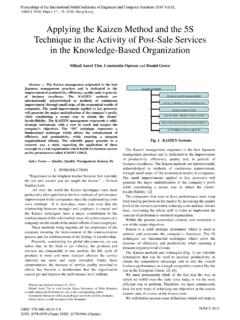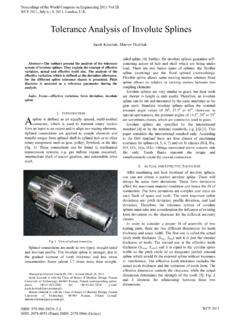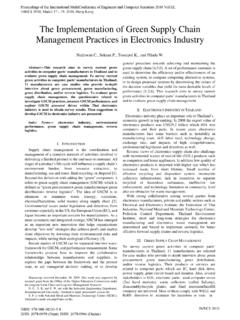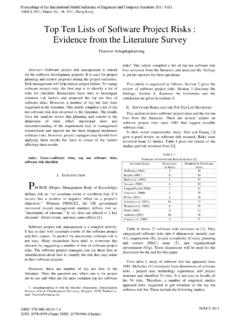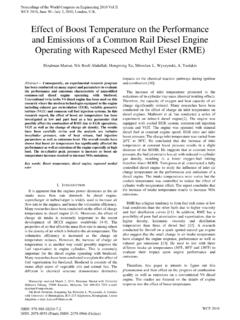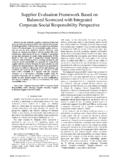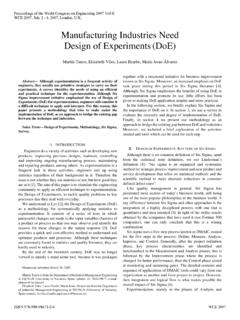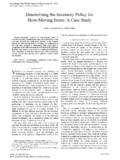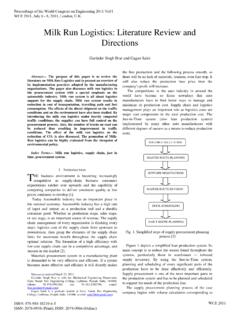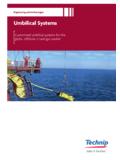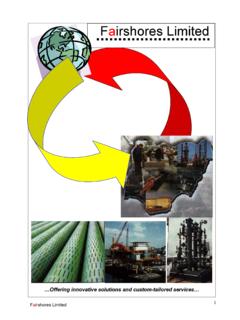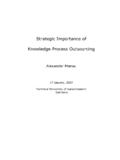Transcription of Achieving Success through Value Engineering: A Case Study
1 Abstract In this paper we have discussed the concept of Value engineering , its job plan and the effective implementation of it through a case Study . Efforts have been put into the articulation of the paper to make it coherent which can be easily perceivable. A case Study has been discussed in this paper involving a part used in the medical instruments. The material is chosen such that the cost is reduced without affecting the quality of the product. The best feasible solution from the available alternatives is chosen through the feasibility ranking table.
2 through the application of Value engineering profits are maximized without hindering the reliability of the product. With the effective utilization of the technique the final outcomes comes out to be a successful showcase of Value engineering . Keywords Functional analysis , LCC, Job Plan, Value engineering , Value Index, ` (Indian National Rupee) I. INTRODUCTION alue engineering is an organized/systematic approach directed at analyzing the function of systems, equipment, facilities, services, and supplies for the purpose of Achieving their essential functions at the lowest life-cycle cost consistent with required performance, reliability, quality, and safety[1].
3 Society of Japanese Value engineering defines VE as: A systematic approach to analyzing functional requirements of products or services for the purposes of Achieving the essential functions at the lowest total cost [2]. Value engineering is an effective problem solving technique. Value engineering is essentially a process which uses function analysis , team- work and creativity to improve Value [3]. Value engineering is not just "good engineering ." It is not a suggestion program and it is not routine project or plan review.
4 It is not typical cost reduction in that it doesn't "cheapen" the product or service, nor does it "cut corners." Value engineering simply answers the question "what else will accomplish the purpose of the product, service, or process we are studying?"[4]. VE technique is applicable to all type of sectors. Initially, VE technique was introduced in manufacturing industries. This technique is then expanded to all type of business or economic sector, which includes Manuscript received June 30, 2012 Amit Sharma is with the Department of Production engineering in PEC University of Technology Chandigarh (phone:+919041293477; Belokar, is with the Department of Production engineering in PEC University of Technology, Chandigarh (Corresponding author phone: +91-172-2753287; construction, service, government, agriculture, education and healthcare [5].))
5 II. HISTORY OF Value engineering During World War II, many manufacturers were forced to use substitute materials and designs as a result of critical material shortages. When the General Electric Company found that many of the substitutes were providing equal or better performance at less cost, it launched an effort (in 1947) to improve product efficiency by intentionally and systematically developing less costly alternatives. Lawrence D. Miles, a staff engineer for General Electric, led this effort. Miles combined a number of ideas and techniques to develop a successful methodological approach for ensuring Value in a product.
6 [6] The concept quickly spread through private industry as the possibilities for large returns from relatively modest investments were recognized. This methodology was originally termed Value analysis or Value control. In 1957, the Navy s Bureau of Ships became the first Department of Defense organization to establish a formal VE program. Miles and another General Electric employee, Raymond Fountain, set up the Bureau of Ships program to help reduce the cost of ship construction, which had nearly doubled since the end of World War II. The Bureau of Ships asked that the technique be called Value engineering and staffed the office with people under the general engineer position description.
7 III. WHAT Value engineering ISN'T Value engineering is not just "good engineering ." It is not a suggestion program and it is not routine project or plan review. It is not typical cost reduction in that it doesn't "cheapen" the product or service, nor does it "cut corners." Value engineering simply answers the question "what else will accomplish the purpose of the product, service, or process we are studying?" It stands to reason that any technique so useful should be applied to every product, and at each stage of the normal day-to-day development of a highway product.
8 This is not the case. The practice of VE entails a certain amount of expense, that must be justified by potential cost savings. Accordingly there must be a recognized need for change and a distinct opportunity for financial benefit to warrant the added cost of a VE effort. Achieving Success through Value engineering : A Case Study Amit Sharma, Belokar, Member, IAENG VProceedings of the World Congress on engineering and Computer Science 2012 Vol II WCECS 2012, October 24-26, 2012, San Francisco, USAISBN: 978-988-19252-4-4 ISSN: 2078-0958 (Print); ISSN: 2078-0966 (Online)WCECS 2012 IV.
9 USING LIFE-CYCLE COSTING WITH Value engineering The concept of economic analysis , which is used in life-cycle costing, requires that comparisons be made between things similar in nature. In Value engineering all alternatives can be compared using life-cycle costing because the alternatives for each project component are defined to satisfy the same basic function or set of functions. When the alternatives all satisfy the required function, then the best Value alternative can be identified by comparing the first costs and life-cycle costs of each alternative.
10 For many projects there is a viable sustainable development alternative or enhancement. Sustainable development may include more recycled material contents, require less energy or water usage, reduce construction waste, increase natural lighting, or include other opportunities that contribute to an optimal facility. The Value engineering methodology can provide for the identification of alternatives, sustainable or eco-efficient design features, and traditional design features, on an equal playing field for comparison. Comparison of alternatives, or the process for identifying the best Value alternative, is accomplished using life-cycle costing along with first-cost estimates.
